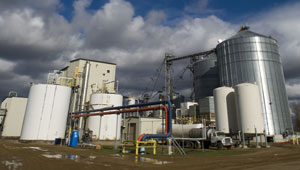 Cellulosic ethanol company Verenium Corporation has regained compliance with the continued listing requirements of the NASDAQ Global Market. NASDAQ previously notified Verenium that it had fallen out of compliance with a rule requiring listed companies on the NASDAQ Global Market to maintain a minimum market capitalization of $50 million. NASDAQ has confirmed that Verenium now meets the requirements of this rule.
Cellulosic ethanol company Verenium Corporation has regained compliance with the continued listing requirements of the NASDAQ Global Market. NASDAQ previously notified Verenium that it had fallen out of compliance with a rule requiring listed companies on the NASDAQ Global Market to maintain a minimum market capitalization of $50 million. NASDAQ has confirmed that Verenium now meets the requirements of this rule.
Obama, Congress Considering Alt Energy in Stimulus Bill
 As leaders in Congress and President-elect Barack Obama look at another possible economic stimulus package, renewable energy sources, such as biodiesel, ethanol, solar and wind, look to get $25 billion in tax credits from the plan.
As leaders in Congress and President-elect Barack Obama look at another possible economic stimulus package, renewable energy sources, such as biodiesel, ethanol, solar and wind, look to get $25 billion in tax credits from the plan.
This story from the Washington Post says the credits could come in either a single bill or a series of legislative moves:
The main elements under consideration include a two-year, $8.6 billion extension of the production tax credit for renewable energy, an item that favors wind power projects. Obama advisers are considering a proposal from the wind and solar industry that would make those credits refundable or count them against past taxes because many financial firms that provided capital for those projects no longer have taxable income and can’t use the credits.
The bill could also include tax credits for service stations that install high-ethanol-content fuel pumps, a $7,500 tax credit for plug-in vehicles, an extension of the biodiesel credit, and one for coal-fired power plants that capture more than half of their carbon emissions or that could be retrofitted to do so later. There could also be clean-energy credits for rural cooperatives.
The stimulus package may also establish a federally funded National Clean Energy Lending Authority, an idea that has been promoted by Rep. Chris Van Hollen (D-Md.) and Rep. Zach Wamp (R-Tenn.). The agency would receive as much as $10 billion to $20 billion and would extend low-interest loans or loan guarantees to renewable energy projects in an effort to mobilize private capital. If successful, Van Hollen said, the agency could become self-sustaining.
The package could also include funds to help homeowners make energy-efficiency improvements.
Biodiesel, Ethanol to Ship Out of Milwaukee Port
 A New York City-based biodiesel maker Innovation Fuels has bought a 310,000-barrel terminal at the Port of Milwaukee, Wisconsin.
A New York City-based biodiesel maker Innovation Fuels has bought a 310,000-barrel terminal at the Port of Milwaukee, Wisconsin.
This story from the Business Journal of Milwaukee says the facility will help move biodiesel and ethanol out of the region:
The terminal includes a 20,000-square-foot warehouse, executive offices and a garage. The site features existing truck and rail loading infrastructure with highway access, and is served by two Class I railways: the Union Pacific Railroad and the Canadian Pacific Railroad. In addition, the Port of Milwaukee has international shipping access via the St. Lawrence Seaway and can receive river barge cargo via the Mississippi. The facility also has an idled connection to the Westshore petroleum pipeline, which could be used to bring diesel and gasoline to the terminal for blending with renewable fuels, such as biodiesel and ethanol.
“This acquisition provides Innovation Fuels with direct, deep-water access to the lucrative Great Lakes and Northeast markets as well as to international ports making the Port of Milwaukee property one of the keys to our global strategy,” commented John Fox, CEO for Innovation Fuels. “We can now easily transport finished product from Midwestern biofuels producers to virtually anywhere on the East Coast of the United States as well as to our international customers.”
Innovation Fuels runs biodiesel refineries as various ports across the country.
US Produces Enough Corn for Food and Fuel
 The final 2008 corn crop estimate from the U.S. Department of Agriculture released today confirmed that American farmers produced the second-largest crop on record with the second highest average yield per acre in history – despite adverse weather across the Corn Belt during the early part of the growing season and a late fall harvest.
The final 2008 corn crop estimate from the U.S. Department of Agriculture released today confirmed that American farmers produced the second-largest crop on record with the second highest average yield per acre in history – despite adverse weather across the Corn Belt during the early part of the growing season and a late fall harvest.
Corn for grain production in 2008 is now estimated to be 12.1 billion bushels, up 1 percent from the November forecast but 7 percent below last year’s record high. The average U.S. grain yield is estimated at 153.9 bushels per acre, up 0.1 bushel from the November forecast and 3.2 bushels above 2007. The 2008 yield is the second highest on record, behind 2004, and production is second largest, behind last year.
 Renewable Fuels Association President Bob Dinneen says the final numbers should dispel the misconception that ethanol is at the root of higher corn and food prices, especially given an expected surplus of nearly two billion bushels at the end of this marketing year. “This report also demonstrates the real size of the demand for corn by ethanol production,” said Dinneen. “At approximately 21 percent of the net total corn use, ethanol demand for corn is providing a much-needed value added market for farmers without having the market-distorting impacts many in the food processing and livestock production industries have claimed.”
Renewable Fuels Association President Bob Dinneen says the final numbers should dispel the misconception that ethanol is at the root of higher corn and food prices, especially given an expected surplus of nearly two billion bushels at the end of this marketing year. “This report also demonstrates the real size of the demand for corn by ethanol production,” said Dinneen. “At approximately 21 percent of the net total corn use, ethanol demand for corn is providing a much-needed value added market for farmers without having the market-distorting impacts many in the food processing and livestock production industries have claimed.”
USDA’s updated world corn supply and demand estimates this month show slightly reduced demand for corn use for ethanol, in addition to reductions in all corn demand. As a result USDA raised its projection of corn carry-out for the end of the 2008/09 marketing year to 1.8 billion bushels, one of the highest levels in the past decade.
Book Review – Storm World by Chris Mooney
“There are many reasons to shift away from fossil fuels, and we will do so in the next century without legislation, financial incentives, carbon-conservation programs, or the interminable yammering of fearmongers.”
Michael Crichton, author’s message at the end of State of Fear
 In 2004, Michael Crichton wrote in his novel, State of Fear, “From the beginning, the movement had had to fight apathy in the broader society. Human beings didn’t think in the long term. They didn’t see the slow degradation of the environment. It had always been an uphill battle to rouse the public to do what was really in its own best interest…that fight was far from over. In fact, it was just beginning.” The book’s premise is that an organization fakes environmental disasters to raise awareness of global warming and ultimately money to “educate consumers.” It could be argued that it was ahead of its time. Or maybe not since the theory of global climate change is still under intense debate.
In 2004, Michael Crichton wrote in his novel, State of Fear, “From the beginning, the movement had had to fight apathy in the broader society. Human beings didn’t think in the long term. They didn’t see the slow degradation of the environment. It had always been an uphill battle to rouse the public to do what was really in its own best interest…that fight was far from over. In fact, it was just beginning.” The book’s premise is that an organization fakes environmental disasters to raise awareness of global warming and ultimately money to “educate consumers.” It could be argued that it was ahead of its time. Or maybe not since the theory of global climate change is still under intense debate.
Which brings us to REAL environmental disasters — hurricanes — which science is arguing whether the increased number and intensity of hurricanes is in fact being caused by global climate change. Storm World, by Chris Mooney, sets out to debate this very issue. The book reminds me of college when during a graduate meteorology class we learned about the possible effects of a warming planet (which no one seemed to really buy into at the time) on the weather. Mooney points out that these predictions began as early as the 1900s. I find it interesting that Americans “rediscover” issues every few decades and then try to play it off as a new crisis. Anyway, I digress.Read More
Introducing the Domestic Fuel Media Reviewer
We are introducing a new regular feature here on Domestic Fuel that will take a look at some of the many books and movies out there that take on the topics of environment, energy and renewables.
 Our Domestic Fuel book and movie reviewer is Joanna Schroeder, who has been the communications director for the Ethanol Promotion and Information Council (now Growth Energy) since September of 2005, and is now starting her own communications company focused on the renewable energy industry. Joanna has a strong background in both environmental science and technical communications, which makes her well qualified to provide in-depth analysis of current literature and film in the field of energy and the environment.
Our Domestic Fuel book and movie reviewer is Joanna Schroeder, who has been the communications director for the Ethanol Promotion and Information Council (now Growth Energy) since September of 2005, and is now starting her own communications company focused on the renewable energy industry. Joanna has a strong background in both environmental science and technical communications, which makes her well qualified to provide in-depth analysis of current literature and film in the field of energy and the environment.
Joanna is an Accredited Public Relations (APR) professional who specializes in PR strategy, issues management, media training, media relations and environmental initiatives. She is in the process of planning a “Communicating Renewables” conference this spring in Minneapolis for communicators working in the alternative energy industry.
Expect to hear more about that in the coming weeks – in the meantime, enjoy her critiques.
NEVC to Hold 2008 Board and Membership Meeting in St. Louis
 The National Ethanol Vehicle Coalition (NEVC) will be holding their 2008 Annual Board of Director and Membership Meeting at the Renaissance St. Louis Airport on January 26-27, 2009. The NEVC invites all to join automakers, marketers, commodity organizations, retailers, equipment manufacturers and MORE to discuss how to further the use of higher blends of ethanol throughout the country.
The National Ethanol Vehicle Coalition (NEVC) will be holding their 2008 Annual Board of Director and Membership Meeting at the Renaissance St. Louis Airport on January 26-27, 2009. The NEVC invites all to join automakers, marketers, commodity organizations, retailers, equipment manufacturers and MORE to discuss how to further the use of higher blends of ethanol throughout the country.
A schedule of events will be as follows:
Monday, January 26:
12 p.m. – 5 p.m.: Executive Session for NEVC Board Members
6 – 9 p.m.: Reception (ALL Welcome)
Tuesday, January 27:
8:30 a.m. – 12 p.m.: Executive Session for NEVC Board Members
1 – 5 p.m.: Continuation of business meeting (ALL Welcome)
Guest speakers expected to attend on the afternoon of January 27 include representatives from the Department of Energy, Underwriters Laboratory, Renewable Fuels Association, Flex Fuel U.S., American Coalition for Ethanol, and more. Cost to attend the meeting is $50 per person. Contact Rhonda Beul, rbeul@e85fuel.com, or the NEVC office, (573) 635-8445, to register by Wednesday, January 21, 2009.
Sponsors for the event are: Ohio Corn Grower Assn., Dresser Wayne, Siouxland Energy and Livestock, Kansas Corn Growers Assn, Missouri Corn Growers Assn., John Deere, and Minnesota Corn Growers Assn.
Biofuels Focus at Farm Bureau Meeting
Biofuels have been a major topic of discussion at the American Farm Bureau Federation 90th annual meeting in San Antonio this week.
 A conference titled “The Growing Role of Biofuels for Today, Tomorrow and Beyond,” featured Brooke Coleman, executive director of the New Fuels Alliance and spokesperson for FoodPriceTruth.
A conference titled “The Growing Role of Biofuels for Today, Tomorrow and Beyond,” featured Brooke Coleman, executive director of the New Fuels Alliance and spokesperson for FoodPriceTruth.
“Agriculture is the key to the new energy economy,” Coleman said. “Biofuels are the key to agricultural revitalization.”
According to Coleman, the biofuels industry has survived a well-orchestrated smear campaign led by food makers and environmental groups and even though the economy has taken a serious downturn, renewable energy is poised for continued growth.
He said many ethanol and biodiesel companies have cash reserves to transition through the current tough times, the cost of breaking down their feedstocks is coming down and several new biofuel plants making advanced ethanol from non-grain feedstocks are coming online.
Ethanol Industry Outlook for 2009
 2008 was a year that for the most part everyone would like to forget – including those in the ethanol industry. Now that 2009 is underway, Renewable Fuels Association president and CEO Bob Dinneen says there are still challenges ahead for the industry – but opportunities as well. That is the subject of this edition of “The Ethanol Report” podcast – the first for 2009.
2008 was a year that for the most part everyone would like to forget – including those in the ethanol industry. Now that 2009 is underway, Renewable Fuels Association president and CEO Bob Dinneen says there are still challenges ahead for the industry – but opportunities as well. That is the subject of this edition of “The Ethanol Report” podcast – the first for 2009.
You can listen to “The Ethanol Report” on-line here:
Ethanol Report on 2009 Outlook
Or you can subscribe to this podcast by following this link.
POET Producing Pilot Cellulosic Ethanol
The world’s largest corn ethanol producer is now successfully producing cellulosic ethanol at a pilot plant in South Dakota.
 According to company officials, POET Research Center in Scotland, S.D. is now producing cellulosic ethanol at a rate of 20,000 gallons per year using corn cobs as feedstock.
According to company officials, POET Research Center in Scotland, S.D. is now producing cellulosic ethanol at a rate of 20,000 gallons per year using corn cobs as feedstock.
“The start-up of the pilot scale facility has been extremely smooth,” said POET CEO Jeff Broin, who held a telephone press conference Monday calling it a “grand opening” of the plant – although weather prevented them from actually holding the call at the facility. “After producing 1,000 gallons, we’ve already been able to validate all of what we learned in the lab and believe the process will be ready for commercialization when we start construction on Project LIBERTY next year.”
Broin stressed the potential for producing cellulosic ethanol from corn cobs and other agricultural waste products. “Because they are being grown today, they don’t require farmers to plant a new crop,” said Broin. “And there are lots of them. Enough to produce five billion gallons of ethanol every year. That’s five billion gallons of ethanol that can come from what is a waste product today.”
Broin is optimistic about being able to achieve commercialization of cellulosic ethanol by 2011 but he hedged when asked whether he thought the industry would be able to meet the goal of 100 million gallons by 2010. “This is a brand new technology, it takes time to develop it, so we’re going to have to have a wait and see attitude,” Broin said. “You can put a number on a piece of paper, but it’s going to come at the speed at which the technology is developed.” However, he noted that the industry has been very successful in the past at meeting and even exceeding the goals set forth.

